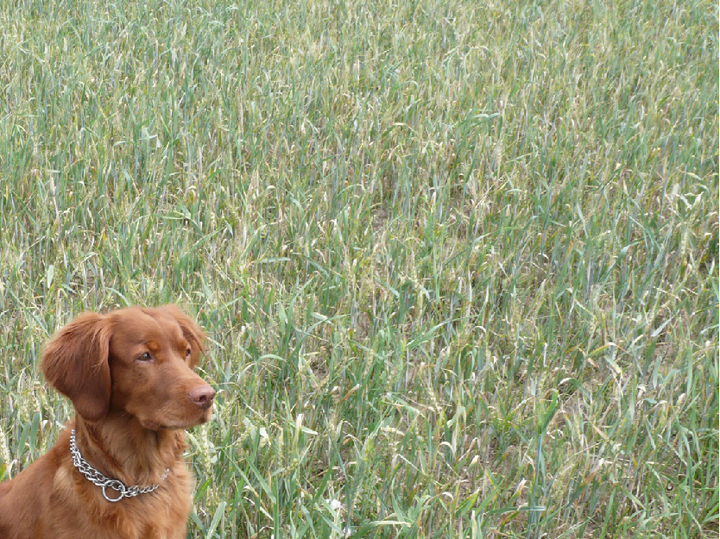Wheat dwarf virus
Wheat dwarf virus (WDV)
Profile
The wheat dwarfing virus belongs to the Geminiviridae group and is transmitted by the migratory sand chirp. Infestation with the virus results in blotchy paling of the leaves as well as severe dwarfing of the entire plant, which leads to a lack of crop yields. Host plants include both winter and summer cereal varieties, but also various grasses.
Biology
Wheat dwarfing virus (WDV) belongs to the Geminiviridae group. It used to be divided into two strains, named barley-strain and wheat-strain, respectively, according to their host plants. In more recent literature, these strains are considered to be two separate viruses, Wheat dwarf virus (WDV) and Barley dwarf virus (BDV). In addition, there is also Oat dwarf virus (ODV, oat dwarf virus), which occurs on oats. In the further course, however, the three viruses are grouped together under WDV.
Damage symptoms

The first symptom of plants infected by WDV is streaky to blotchy lightening on the leaves, which later also turn yellow. Winter barley, for example, reacts after an early infection with a strong dwarfing and a stronger tillering. Shooting and ear formation also mostly do not take place, resulting in a loss of crop yield. In most cases, the roots of infected plants are also weakly developed.
It is not possible to distinguish the disease from Barley yellow d warf virus (BYDV) on the basis of the symptoms. In this case, certainty can only be obtained by laboratory examination.
Host plants
Of the crops relevant to arable farming, winter barley, winter wheat, triticale and oats, as well as spring cereals, are mainly attacked. However, some grasses such as sandy oat or rough oat(Avena strigosa), rye trespe (Bromus secalinus), velvet grass(Lagurus ovatus), Italian ryegrass (Lolium multiflorum), German ryegrass (Loliumperenne), toadflax (Loliumremotum), tumbleweed (Loliumtemulentum) or annual bluegrass (Poa annua) can also be infected.
However, there are also grasses that are not susceptible to this type of viral disease such as the Ungrassed Tresper (Bromus inermis), the Soft Tresper (Bromus mollis), the Meadow Knapweed(Dactylis glomerata), the Chicken Millet(Echinochloa crus-galli), common couch grass(Agropyron repens), meadow fescue(Festuca pratensis), bluegrass(Poa pratensis), timothy(Phleum pratense), red canary grass (Phalaris arundinacea), foxtail millet (Setaria italica), or green bristle millet (Setariaviridis).
Experiments with maize showed that, although a single inbred line could be infected, no natural infestation of a maize variety has yet been reported from cultivation practice.
Distribution
Wheat dwarf virus is more or less widespread in Europe, North America, Canada and China.
Wheat dwarf virus was first detected on wheat(Triticum aestivum) in 1961 in what was then Czechoslovakia. Other findings are known from Sweden (Lindsten, 1980) and France (Vacher et al., 1991). In the 1993 and 1994 growing seasons, WDV was increasingly detected on winter barley in Germany (Saxony-Anhalt) (Habekuß, 2003). In Austria, the virus was first detected in 2004 (Plank, 2004).
Propagation and transmission
The virus is transmitted in a persistent manner by the leafhopper Psammotettix alienus (wanderer's cicada). Persistent means that after ingestion of the virus a certain period of time (in the case of WDV 24 to 72 hours) elapses before the virus can be released again. The vector (the cicada), however, remains infectious throughout its life, and the virus cannot be passed on to offspring. If an infected cicada bites a wheat plant, for example, it takes only a few minutes for the virus to be transmitted. All larval stages can ingest and pass on the virus, as can the adult insect, but young larvae are most effective in transmission.
Permanent sources of infection are some grass species such as annual ryegrass(Poa annua), ryegrass(Lolium perenne), tumbleweed(Lolium temulentum), or rye trespe(Bromus secalinus). In addition, volunteer cereals and already infected cereal plants also play a major role.
Due to the high mobility of the cicadas, infections can spread rapidly in a crop. However, mechanical transmission of WDV can be ruled out, as can transmission by plant-to-plant contact. The virus is not seed-borne and thus cannot be transmitted via seed.
Vector
The wanderer's sand chirp(Psammotettix alienus) usually forms two generations in our country. Only in years with very favorable weather conditions and at warm locations, a third generation of this leafhopper can develop.
Hibernation occurs as an egg, with the short day towards autumn inducing egg dormancy (dormancy). The eggs are not infected with the virus. The first larvae of the cicadas hatch around the end of April and develop through four further larval stages (L1 to L5) to adults (=imagines). All these stages can ingest the virus during their sucking activity and then spread it further.
Depending on the weather, the adults of the first generation appear from mid-May to mid-June. The larvae of the second generation are then found from about the end of June or beginning of July. The imagines of the second generation appear towards the end of July. The animals are still active at temperatures between 10 and 15 °C and they can continue to infect new plants during this time. The more cold-tolerant females die only at temperatures below -5 °C, whereas the less resistant males die much sooner.
Specialized information
Since 2019, we have been carrying out cereal virus monitoring in cooperation with the chambers of agriculture. Interested farmers can use the cereal virus monitoring to get an overview of the virus situation in their region and, if necessary, postpone the time of cultivation.
Last updated: 02.10.2025
automatically translated